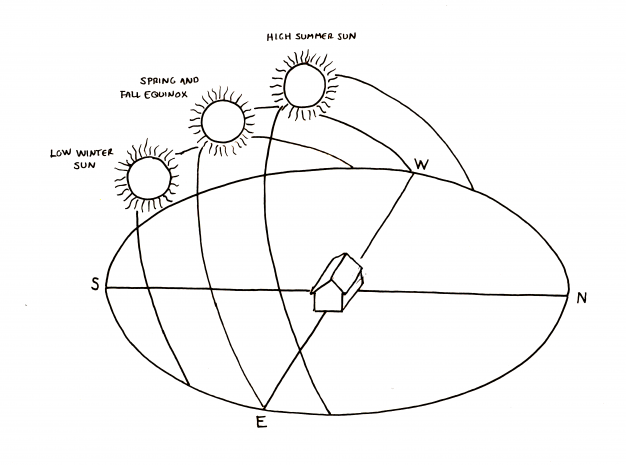Passive Solar Heating
HVAC: MATERIALS ENCYcLOPEDIA
Heat production & delivery
Solar heat production
Passive heat transfer
Passive air delivery
System components
South-facing glazing
Thermal mass, as required
How the system works
 Passive solar heating is not really a heating system; rather it is a design approach that has space heating benefits. Windows are arranged on the south-facing side of the building such that they are 10–30 percent of the floor area of the room behind. They are positioned to receive the full penetration of the low winter sun, and provided with static or active shading to prevent penetration of the high summer sun.
Passive solar heating is not really a heating system; rather it is a design approach that has space heating benefits. Windows are arranged on the south-facing side of the building such that they are 10–30 percent of the floor area of the room behind. They are positioned to receive the full penetration of the low winter sun, and provided with static or active shading to prevent penetration of the high summer sun.
Solar radiation enters the windows and warms the air and the mass in the room.
System output
Output can vary greatly depending on a number of factors:
- Available solar radiation
- Latitude
- Transmission rating of glazing
- Climatic conditions (hours of clear sunlight
In northern climate studies, effective passive solar design has been shown to provide a solar heating fraction of 10–35 percent. While this is far from the full heating load, it is entirely free and significantly reduces the requirement for other heating systems.
Environmental impacts: None
Passive solar is a benign approach.
Material costs: Negligible to Moderate
Adjustments to window sizes and glazing types will have minimal impact on costs. Active window shading will add costs, but a great deal more passive solar benefit.
Labor input: Negligible
No additional labor is required, unless active window shades are installed.
Skill level required for the homeowner
Installation — Easy.
Use — Easy.
Maintenance — Easy.
Sourcing/availability: Easy
As long as the building site has some access to the sun, passive solar approaches are freely available.
Code compliance
Building codes do not address passive solar design. Some codes may restrict the amount of glazing on a particular face of the building, depending on proximity to other structures.
Durability: High
There are no durability issues with passive solar, unless active window shades are used.
Indoor air quality: High
Passive solar will not have a direct effect on indoor air quality. If a reasonable amount of heat is generated in this way, it will reduce the need for the use of other heating systems, many of which do have IAQ issues.
Future development
Better computer models for calculating passive solar are being developed, and this will help to refine designs and make passive solar easier for all designers to employ. The more accurate the computer model, the easier it becomes to make small changes that have real-world energy results.
Resilience
Passive solar is a highly resilient approach, requiring no energy input to receive benefits.
Tips for a successful Passive Solar Design
1. There are many resources available for calculating ideal passive solar attributes in different latitude and climatic zones. Use these to create the most advantageous design. Good computer modeling software can be very helpful in this regard.
2. In many climates, cold and warm alike, the shading aspects of passive solar design can produce more energy savings by reducing cooling needs than heat gains in the winter. This is an oft-ignored element of passive solar design that has significant benefits.
3. Passive solar design is not an all-or-nothing proposition. Even when site conditions may not be conducive to best-case passive solar design, any amount of solar fraction (or summer shading benefit) that can be gained will be worthwhile. Passive solar optimization can be done on any building on any site.
4. Be conscious about choosing the correct window glazing and coatings for windows. A reasonable degree of solar gain and solar reflectance can be achieved with glazing selected for each exposure of the building.
5. Don’t over-glaze or overdo the amount of thermal mass used. More is not always better. A balance must be struck between gains received from windows when the sun is shining and losses through the windows when it is not. Too much thermal mass can make it impossible for a day’s worth of solar radiation to raise the temperature of the mass noticeably.



